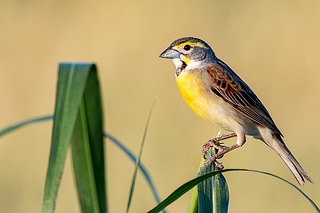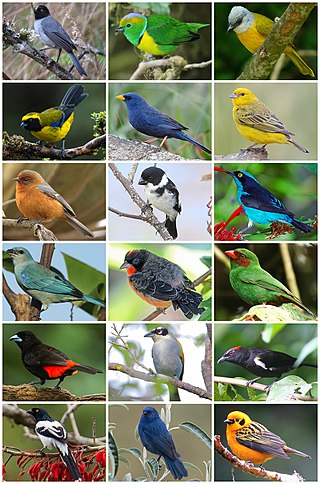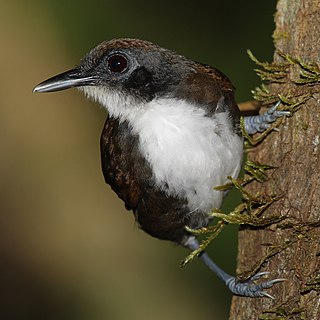
Cardinalidae is a family of New World-endemic passerine birds that consists of cardinals, grosbeaks, and buntings. It also includes several other genera such as the tanager-like Piranga and the warbler-like Granatellus. Membership of this family is not easily defined by a single or even a set of physical characteristics, but instead by molecular work. Among songbirds, they range from average-sized to relatively large, and have stout features, some species with large, heavy bills.

The tanagers comprise the bird family Thraupidae, in the order Passeriformes. The family has a Neotropical distribution and is the second-largest family of birds. It represents about 4% of all avian species and 12% of the Neotropical birds.

The scarlet tanager is a medium-sized American songbird. Until recently, it was placed in the tanager family (Thraupidae), but it and other members of its genus are now classified as belonging to the cardinal family (Cardinalidae). The species' plumage and vocalizations are similar to other members of the cardinal family, although the Piranga species lacks the thick conical bill that many cardinals possess. The species resides in thick deciduous woodlands and suburbs.

The summer tanager is a medium-sized American songbird. Formerly placed in the tanager family (Thraupidae), it and other members of its genus are now classified in the cardinal family (Cardinalidae). The species's plumage and vocalizations are similar to other members of the cardinal family.

The western tanager, is a medium-sized American songbird. Formerly placed in the tanager family (Thraupidae), it and other members of its genus are classified in the cardinal family (Cardinalidae). The species's plumage and vocalizations are similar to other members of the cardinal family.

The red-crowned ant tanager is a medium-sized passerine bird from tropical America. It is the only species now placed in the genus Habia. This species was long placed with the tanagers (Thraupidae), but it is actually closer to the cardinals (Cardinalidae).

The name army ant (or legionary ant or marabunta) is applied to over 200 ant species in different lineages. Because of their aggressive predatory foraging groups, known as "raids", a huge number of ants forage simultaneously over a limited area.

The silver-throated tanager is a species of passerine bird in the tanager family Thraupidae. It is found in Costa Rica, Panama, Colombia, Ecuador, and northeastern Peru. It inhabits mossy forests, montane evergreen forests, tropical lowland evergreen forests and forest edges, along with tall secondary forests and disturbed habitat with remnant trees and forest. It is 13 centimetres (5.1 in) long and weighs 22 grams (0.78 oz) on average, and shows slight sexual dimorphism, with duller female plumage. Adult males are mainly bright yellow, with a silvery-white throat bordered above with a black stripe on the cheeks, black streaking on the back, and green edges to the wings and tail. Juveniles are duller and greener.

The hepatic tanager is a medium-sized American songbird. Formerly placed in the tanager family (Thraupidae), it and other members of the genus Piranga are now classified in the cardinal family (Cardinalidae).

Eciton hamatum is a species of army ant in the subfamily Dorylinae; it is found from Mexico to central Brazil and Bolivia. The species differs from Eciton burchellii, in that it does not fan out into the underbrush when foraging. Rather, it forages in columns, often in trees and preying exclusively on the larvae of other social insects. Its prey are often broods of vespid wasps and ants of genera Dolichoderus and Camponotus, suggesting that E. hamatum is mainly an arboreal forager.

Eciton is a New World army ant genus that contains the most familiar species of army ants. The most predominant and well-known species is Eciton burchellii, which is also more commonly known as the army ant and is considered the type species.

The olive-backed tanager is a species of bird in the family Mitrospingidae. It is found in Brazil, Guyana, and Venezuela.

The grey-crowned palm-tanager or grey-crowned tanager is a Near Threatened species of bird in the family Phaenicophilidae, the Hispaniolan palm-tanagers. It is endemic to the Caribbean island of Hispaniola, in both the Dominican Republic and Haiti.

The red-headed tanager is a medium-sized American songbird in the family Cardinalidae, the cardinals or cardinal grosbeaks, endemic to Mexico. Comprising two subspecies, it is around 15 cm (5.9 in) long. Males have predominantly yellow-olive plumage with a red head and throat and females have yellow forecrowns.

The white-winged tanager is a medium-sized American songbird in the family Cardinalidae, the cardinals or cardinal grosbeaks. It is found from Mexico, through Central America, across northern South America and as far south as Bolivia.

The rose-throated tanager is a medium-sized songbird in the family Cardinalidae, the cardinals or cardinal grosbeaks. Endemic to the Yucatán Peninsula in Central America, it is found in Belize, Guatemala, and Mexico. The male has greyish plumage with a deep rose throat and crown, while the female is similar but for a yellow crown and throat.

The red-hooded tanager, is a medium-sized American songbird in the family Cardinalidae, the cardinals or cardinal grosbeaks. It is found in Colombia, Ecuador, and Peru.

The saffron-crowned tanager is a species of bird in the family Thraupidae. Found in the northern Andes of Bolivia, Colombia, Ecuador, Peru, and Venezuela, it inhabits cloud forest, forest edges, and secondary forest, preferring areas with mossy trees. It is an average-sized species of tanager with a blue-green body and yellow head with a black forecrown, lores, orbital area, and chin.

Ant followers are birds that feed by following swarms of army ants and take prey flushed by those ants. The best-known ant-followers are 18 species of antbird in the family Thamnophilidae, but other families of birds may follow ants, including thrushes, chats, ant-tanagers, cuckoos, motmots, and woodcreepers.

The Inti tanager, also known as the San Pedro tanager, is a species of bird in the family Thraupidae. It is the only member of the genus Heliothraupis. It is restricted to the lower Yungas of western Bolivia and southern Peru. Despite its striking coloration, call, and evolutionary distinctiveness, it was only described in 2021, and the bird's discovery and documentation to Western science only occurred during the prior two decades. On January 31, 2022, the South American Classification Committee of the American Ornithological Society (SACC) announced its formal addition to their South American species list.























